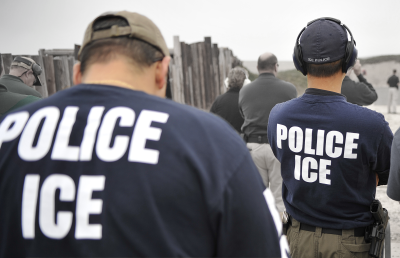Interior Enforcement

New Report Measures Widening Gap Between Republicans and Latino Voters
A New York Times article from 1882 stated, “It is a trite saying that in a free country public opinion rules. […] It often happens that a question of policy becomes of pressing importance before public opinion develops in regard to it.” More than one-hundred years later, this idea remains true—especially in regard to Latino voters and the Republican Party. Read More

Faith and Leadership Required: A Closer Look at Last Week’s White House Meeting
Last week’s White House meeting on immigration marked another chapter in the years-long effort to enact comprehensive immigration reform. Janet Napolitano’s invitation to more than one hundred representatives from business, labor, faith, law enforcement, and immigration groups was a genuine attempt to listen to concerns and solicit ideas. The format—large group meeting addressed by the Secretary, small group discussion led by various DHS and White House officials, summary and surprise remarks from the President—gave people a chance to say just a little, but the cumulative effect was more important than we may realize. Read More

States and Localities Critical to Immigration Policies
Governors and mayors, state legislatures and city councils are playing an increasingly critical role in U.S. immigration policy. As a result of Congress’s inaction, states and localities are feeling pressure to take action on immigration, and many of the policies that directly impact immigrants’ lives—law enforcement, public benefits, driver’s licenses—are being driven by new state and local laws. Some state and local immigration policies have been positive and have helped to integrate immigrants into American communities. Others, however, have had a harmful impact on immigrants as well as on public health and safety. The National Conference of State Legislatures (NCSL), a bipartisan organization that serves the legislators and staffs of the nation's 50 states, recently published two documents that highlight the role that states play in immigration policy. One is a report on recent state activity, and the other is NCSL’s official immigration policy statement. Read More

What’s Law Got To Do With It? Sheriff Arpaio Defies New DHS Enforcement Guidelines
The Department of Homeland Security recently standardized its 287(g) immigration enforcement agreements with local law enforcement, which allows specially trained local enforcement officers to enforce federal immigration laws. Among the new DHS rules, local law enforcement must now prioritize immigrants with serious criminal records, rather than spend scant time and resources going after undocumented immigrants who are charged with no other crime. These new enforcement provisions, however, leave long-time immigration enforcement abuser, Arizona Sheriff Joe Arpaio, with some important decisions to make. Read More

Kicking Down Doors, Stomping on Rights: New Report Reveals Disturbing Details of ICE Raids
Last week the Immigration Justice Clinic of the Benjamin N. Cardozo School of Law at Yeshiva University in New York published a disturbing study that documents ICE’s home raid operations. Constitution on ICE: A Report on Immigration Home Raid Operations found that over the last several years, ICE has increasingly conducted home raids, meaning that they gone to private homes to arrest people rather than doing it in public settings. The report finds a pattern of constitutional violations occurring during home raids including agents kicking in doors and forcing their way into private residences during pre-dawn hours without warrants or other legal authority. ICE agents also seize non-target residents, or “collaterals” from their homes, even if there is no legal authority to take that individual into custody. According to the report, these arrests are based on racial or ethnic profiling. Finally, the authors also found that ICE was illegally searching homes. The stories speak for themselves... Read More

New Yorker Profile of Joe Arpaio is Not a Pretty Picture
The July 20th issue of The New Yorker paints a detailed portrait of Maricopa County, Arizona’s Sheriff Joe Arpaio—and it is not a pretty picture. The profile of “Sheriff Joe” that emerges from the story by journalist William Finnegan is that of a man obsessed with publicity and self-promotion, who has a deep streak of sadism and little regard for the U.S. Constitution, civil rights, actual crime-fighting, or protecting the safety of the public he ostensibly serves. While Arpaio persists in his personal crusade against unauthorized immigrants, serious crimes go unsolved, emergency-response times climb, and the rights of native-born Americans and immigrants alike are routinely trampled in the process. The most remarkable aspect of this story is that Arpaio is still legally permitted to carry a badge and a gun after more than a decade and a half of egregiously abusing his power. Read More

New Yorker Profile of Joe Arpaio is Not a Pretty Picture
Photo by TheRagBlog. The July 20th issue of The New Yorker paints a detailed portrait of Maricopa County, Arizona’s Sheriff Joe Arpaio—and it is not a pretty picture. The profile of “Sheriff Joe” that emerges from the story by journalist William Finnegan is that of a man obsessed with publicity and self-promotion, who has a deep streak of sadism and little regard for the U.S. Constitution, civil rights, actual crime-fighting, or protecting the safety of the public he ostensibly serves. While Arpaio persists in his personal crusade against unauthorized immigrants, serious crimes go unsolved, emergency-response times climb, and the rights of native-born Americans and immigrants alike are routinely trampled in the process. The most remarkable aspect of this story is that Arpaio is still legally permitted to carry a badge and a gun after more than a decade and a half of egregiously abusing his power. Read More

Policy or Politics? DHS Changes and Expands 287(g) Program
Last Friday, Department of Homeland Security (DHS) Secretary Janet Napolitano announced changes to the controversial 287(g) program—a program which allows state and local police agencies to partner with ICE to enforce federal immigration laws. DHS also announced that, rather than waiting for the new policies to be implemented and tested, it has expanded the problematic 287(g) program with 11 new Memoranda of Agreement (MOAs). The 287(g) program has been broadly criticized by immigrant and civil rights advocates, religious leaders, elected officials and the police themselves. Numerous reports from think tanks, academics, community organizations and police associations have shown that the 287(g) program costs valuable resources, results in mistakes and racial profiling, does not effectively control illegal immigration, and makes it more difficult for the police to serve and protect their communities. Even the government found fault with how the program was being implemented. A March 2009 report by the Government Accountability Office (GAO) found the 287(g) program did not have clear goals and objectives and lacked consistent supervision. Read More

Community Backlash Over Utah’s Flawed Immigration Law
Utah’s “get tough on immigration” legislation, Senate Bill 81 (SB81), went into effect last week on July 1st. The litany of protests from faith groups, local police, and conservatives, however, demonstrates the futility of trying to solve a federal immigration problem through state law. Even Utah Gov. Jon Huntsman Jr. hesitated before signing SB81 into law back in March 2008, hoping the federal government would intervene with a national immigration reform bill before the July 1st implementation date. Read More

Major City Police Chiefs Just Say No To Immigration Enforcement
Tired of spending scant time and resources on immigration enforcement, major city police chiefs called on Congress, Wednesday, to move on comprehensive immigration reform. Like most law enforcement officers across the country, chasing down undocumented immigrants proves to be too much of a strain when faced with real priorities… Read More
Make a contribution
Make a direct impact on the lives of immigrants.
